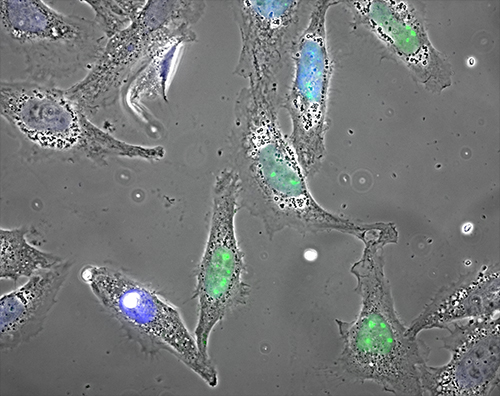Emergency Alert in the Cell – Scientists identify new mechanisms in the cellular stress response

When a cell is exposed to life-threatening conditions, the protein HSF1 (marked in green) initiates an emergency program to prevent permanent damage to the cell. Picture: Christian Loew / Copyright: MPI of Biochemistry
When an organism is exposed to life-threatening conditions, it sounds the alarm and a cellular emergency program, the heat shock response, is initiated. However, the name “heat shock response” is misleading.
In the beginning of the 1960s, this form of stress response was first observed. Scientists exposed fruit flies to high temperatures and discovered a complex emergency program designated to save single cells and thus the organism itself. Today researchers know that this program is also triggered by other dangers such as radiation or toxic substances. The terminology, however, is still in use.
During the heat shock response, different stress proteins are synthesized. Their task is to prevent permanent damage to the organism. “You can compare it to an emergency alert. In order to restore the original status as soon as possible, problems and damages are identified, counter-measures initiated and coordinated”, Loew describes the processes in the cell.
In a comprehensive analysis, the Max Planck scientists have investigated 15 000 proteins and their role in the heat shock response. They could show that the helpers are organized in different groups according to their tasks and disaster zones. One group of proteins, for instance, checks whether the DNA in the nucleus is still intact.
The protein HSF1 (short for heat shock transcription factor) is responsible for the central coordination of the disaster management. In the moment it is activated, it calls a variety of other proteins into action to eliminate the damages. The scientists could demonstrate two ways in which this control center in itself is regulated. When the crisis is overcome, HSF1 is degraded by the cell’s waste disposal system, the proteasome. As long as there is still damage to get rid of, another protein (Acetyltransferase EP300) prevents the degradation.
The understanding of the heat shock response could also be of interest for neurodegenerative diseases such as Alzheimer’s or Parkinson’s, so the scientists in Martinsried hope. Typical for these diseases are massive cell damages and, thus, the excessive demand on the cellular quality control. Nerve cells die and cannot fulfill their tasks in the brain anymore. “A targeted activation of the heat shock response could reduce the disease specific cell damages,” explains Loew.
S. Raychaudhuri, C. Loew, R. Körner, S. Pinkert, M. Theis, M. Hayer-Hartl, F. Buchholz and F. U. Hartl: Interplay of Acetyltransferase EP300 and the Proteasome System in Regulating Heat Shock Transcription Factor 1. Cell, February 27, 2014.
DOI: 10.1016/j.cell.2014.01.055
Prof. Dr. F.-Ulrich Hartl
Cellular Biochemistry
Max Planck Institute of Biochemistry
Am Klopferspitz 18
82152 Martinsried
Germany
E-Mail: uhartl@biochem.mpg.de
http://www.biochem.mpg.de/hartl
Anja Konschak
Public Relations
Max Planck Institute of Biochemistry
Am Klopferspitz 18
82152 Martinsried
Germany
Tel. +49 89 8578-2824
E-Mail: konschak@biochem.mpg.de
http://www.biochem.mpg.de
Media Contact
All latest news from the category: Life Sciences and Chemistry
Articles and reports from the Life Sciences and chemistry area deal with applied and basic research into modern biology, chemistry and human medicine.
Valuable information can be found on a range of life sciences fields including bacteriology, biochemistry, bionics, bioinformatics, biophysics, biotechnology, genetics, geobotany, human biology, marine biology, microbiology, molecular biology, cellular biology, zoology, bioinorganic chemistry, microchemistry and environmental chemistry.
Newest articles

A universal framework for spatial biology
SpatialData is a freely accessible tool to unify and integrate data from different omics technologies accounting for spatial information, which can provide holistic insights into health and disease. Biological processes…

How complex biological processes arise
A $20 million grant from the U.S. National Science Foundation (NSF) will support the establishment and operation of the National Synthesis Center for Emergence in the Molecular and Cellular Sciences (NCEMS) at…

Airborne single-photon lidar system achieves high-resolution 3D imaging
Compact, low-power system opens doors for photon-efficient drone and satellite-based environmental monitoring and mapping. Researchers have developed a compact and lightweight single-photon airborne lidar system that can acquire high-resolution 3D…





















